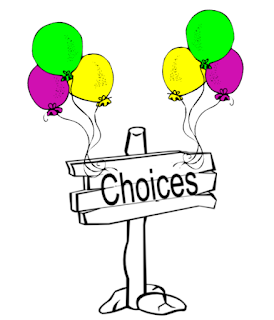Raise your hand if you enjoy being told what to do all the time. I can't see you, but I'm pretty sure your hand did not go up. You like making decisions for yourself and so do I. Well, guess what? Kids appreciate having choices, too. And, we can help them out by infusing choices into our classrooms and teaching our young people how to make those choices responsibly.
Let's be clear. No one is suggesting free reign over the classroom, but there are a couple of ways to provide your students with some say-so in their learning:
✩ Students Choose the Process
Providing students with an opportunity to choose how they learn creates a sense of ownership. Here are some simple ways you can give students process choices:- Allow flexible seating: give students the choice to work while standing, sitting on the floor, or sitting at their desk. (More on flexible seating ideas here.)
- When researching, give students the choice of what resources to use. Give them selections of books and websites.
- Give students a series of "Must do" and "May do" tasks for the lesson, but allow them to choose the order in which they'll complete them.
OR
✩ Students Choose the Product
Rather than making 25 cloud flip books that look exactly the same, you can let students choose what product they will create to represent their learning. It works like this: give students a list of criteria they have to meet (for instance, needs to have representations of the four main cloud types; needs to list what kind of weather is usually associated with each), a choice of materials (crayons, markers, construction paper, cotton balls, stuffing, fabric, etc.), and then let the kids go to town with their imaginations. The sky's the limit (ha!) as long as they meet the criteria.Other ways to let students choose the product:
- Choice boards allow students to select one or more ways
- Learning menus give students options between appetizers (small portions of the assignment), entrees (main portions of the assignment), and desserts (extra portions). With learning menus, your students gain the freedom of creating a unique final project.
- Tell students they need to make a digital product using Google Apps, but don't specify whether they have to use Google sites, Google slides, Google docs, etc..
Making It Work
One of the keys to making student choices in the classroom successfully is that teachers have to explicitly teach and model how to make appropriate choices. For instance, if you're going to have a classroom with a couch, you have to model for students how to sit on the couch and how to not sit on the couch. You need a system for determining who gets to sit on the couch when, for how long, and what happens if it's not done appropriately.If you're letting students choose how to conduct their research, you'll want to give them a graphic organizer to use, model how to choose appropriate resources, and how to share resources if they're limited.
Similarly, if you're going to allow students to choose a product to create to demonstrate their learning, you need to set clear parameters ahead of time around that product and then check in frequently with students to make sure they're meeting those parameters.
In other words, you're not letting go of control. Instead, you're teaching students how to make good choices...which is probably one of the most important skills they can learn in life.
Now that you're a pro...
Create a goal to get yourself started! Sample goals:- During the first quarter, I will allow students to make at least one instructionally relevant choice each week.
- By the end of the first quarter, I will create five options for flexible seating in my classroom.
- During the first quarter, I will implement choice boards as weekly homework for my class.
Hampton City Schools Teachers
Do you work in Hampton City Schools? Great! Here are some ideas for how to give students choices using the Instructional Technique Library. (If you don't work at Hampton City Schools, you should. Look at all the fun we're having!)
- Show Don't Tell: Students get to choose how they will represent the concept that you give them.
- Thinking Maps: (and other graphic organizers): Let students choose how they will organize
- Socratic Seminar: When done well, students learn to lead discussions around relevant tasks, discussing things they think are important and making connections
 |
Robyn Crump, Curriculum Integration Technology Teacher
(former Grade Three Teacher)
Hampton City Schools
rcrump@hampton.k12.va.us
|






No comments:
Post a Comment
Thank you for commenting! We love comments!